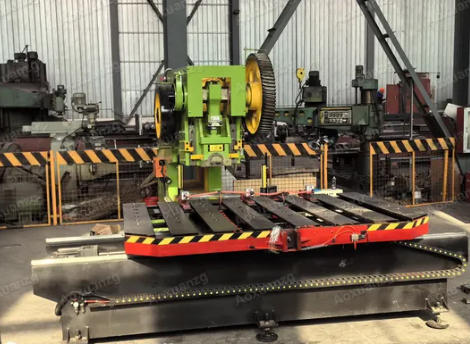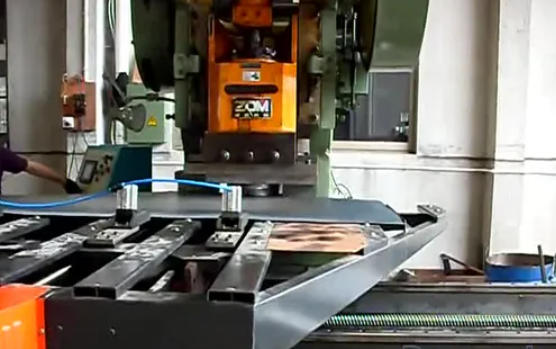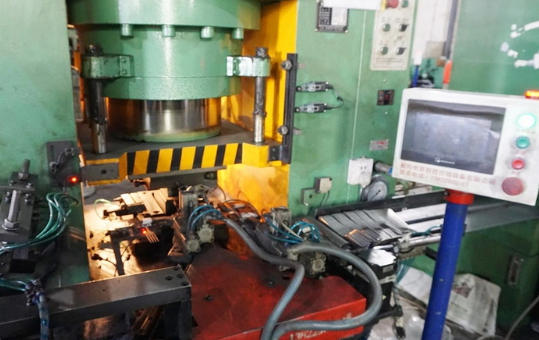Views: 222 Author: Rebecca Publish Time: 2025-11-12 Origin: Site









Content Menu
● What Are Automatic Feeder Systems?
● Types of Automatic Feeder Systems
>> Step Feeders
>> Elevator and Hopper Feeders
>> Conveyor and Robotic Feeders
● Criteria for Selecting an Automatic Feeder System
● Advanced Features and Innovations
● Implementation Challenges and Solutions
● Maximizing Feeder System ROI
● The Future of Automatic Feeder Systems
● FAQ
>> 1. What factors most impact feeder system selection?
>> 2. Are flexible feeders suitable for high-volume production?
>> 3. How do automatic feeders enhance product quality?
>> 4. What maintenance does an automatic feeder require?
>> 5. Can automatic feeders integrate with existing factory automation?
Selecting the ideal automatic feeder system is more than a technical decision—it is a strategic investment that impacts productivity, product quality, and operational costs. In today's competitive manufacturing environment, efficiency and flexibility hinge on your ability to implement the right automation for your unique needs. This comprehensive article explores feeder system types, selection criteria, industrial applications, and advanced integration strategies, ensuring your next investment achieves the best possible results.

Automated feeder systems have revolutionized manufacturing by enabling continuous, precise, and reliable delivery of components to assembly lines, packaging machinery, and specialized workstations. These systems minimize human intervention, slash error rates, and support both mass production and customized batch operations. Understanding the differences among available feeder technologies is crucial to optimizing your operation's performance.
Automatic feeder systems are engineered machines deployed in production environments to continually supply parts, materials, or products to downstream equipment. Commonly found in electronics, automotive, medical device, packaging, and food industries, these systems can handle a wide variety of part sizes, shapes, and fragilities. They replace manual handling, enabling high-speed and accurate placement, orientation, and sorting tasks.
Key benefits include:
- Reduced manual labor
- Consistent throughput
- Improved process reliability
- Greater scalability and flexibility
- Enhanced safety and ergonomic conditions
These feeders are the backbone of automated component handling, especially for small parts. Vibratory bowl feeders use oscillating motion to convey, orient, and sort parts using gravity and precise toolings within the bowl. They excel in high-speed operations, multi-part orientation, and seamless integration with automation.
Centrifugal feeders use rotary motion to propel lightweight parts against a bowl wall. Well-suited for high-volume, low-friction components, these feeders deliver rapid rates with minimal noise. Custom toolings make them valuable for packaging, medical, and consumer goods where gentle part handling is vital.
Linear feeders gently transport parts using vibration along straight tracks, providing precise placement and reduced risk of damage. They are commonly paired with bowl feeders for downstream movement and are ideal for delicate items in electronics, glass, and pharmaceuticals.
Step feeders use mechanical steps to elevate and move parts, promoting quiet operation and specialized handling for cylindrical or spherical items. Applications include automotive pins and medical syringes where orientation and part integrity matter.
Elevator feeders utilize belts or buckets to elevate bulk materials, commonly found in food processing and pharmaceutical manufacturing. Hopper feeders store and dispense components for upstream bowl or conveyor systems, ensuring continuous supply in high-volume environments.
Flex feeders represent the cutting edge, using flat vibrating plates, machine vision, and robotics to identify and orient mixed parts. Ideal for “batch-of-one,” high-mix, and frequent model changes, flex feeders support ultimate adaptability for modern manufacturers.
Conveyor-based feeders synchronize horizontal movement of components and materials, while robotic feeders integrate with machine vision and AI for adaptive sorting, placement, and orientation. These systems are perfect for operations requiring rapid changeovers and diverse product runs.

Making the right choice requires evaluating your unique operational needs and constraints:
- Part Complexity: Simple geometry parts may favor bowl or centrifugal feeders, while irregular, fragile, or multi-type components require flex or linear feeders.
- Required Throughput: High-speed production lines benefit from centrifugal or multi-lane vibratory feeders; batch operations may benefit from flexible feeders.
- Orientation and Precision: Bowl feeders excel at orienting components; flex and robotic feeders suit less standardized requirements.
- Integration and Footprint: Assess available space, compatibility with existing equipment, and ease of integration with your control systems.
- Flexibility: For frequent product switches or multiple part types, invest in systems with quick changeover capability.
- Maintenance and Reliability: Balance upfront costs with ongoing support, spare part availability, and ease of access for repairs.
- Budget and ROI: Consider investor payback, labor savings, reduced errors, and improved product quality.
Recent advancements in feeder technology provide even greater customization and integration capabilities:
- Programmable Feeding Schedules: Software-driven feeding robots deliver precise mixtures and dispensing routines, critical in agriculture and food processing.
- Machine Vision and AI Integration: Automated defect detection, adaptive sorting, and real-time retooling enable smart factories to handle variable demand and batch sizes.
- Real-Time Monitoring and Remote Control: IoT-enabled feeders offer performance tracking, predictive maintenance, and centralized oversight.
Industrial case studies demonstrate the measurable impact of well-chosen feeder systems:
- Medical Manufacturing: A multi-lane vibratory bowl feeder delivered 12 small plastic medical parts every three seconds with zero margin for error. The precise part count and reliable operation ensured strict compliance and supported rapid product changeovers.
- Automotive Assembly: Vibratory and conveyor-based feeders prepared colored automotive clips for assembly, maintaining high throughput and reducing downtime with integrated counting and placement solutions.
- Food and Agriculture: Livestock and pig farms adopted automated feeding robots with programmable schedules, reducing feed waste, improving animal health, and enabling remote monitoring through central control systems.
- Pharmaceuticals: Linear and step feeders gently conveyed fragile vials and ampoules, safeguarding products while supporting automated packaging lines.
Automatic feeders, while transformative, present implementation challenges that require proactive solutions:
- Changeover Complexity: Flexible and robotic feeders streamline adjustment, minimizing downtime during part-type switches.
- Space and Layout Constraints: Modular, compact feeders and elevator/hopper combinations maximize limited floor space.
- Operator Training: User-friendly interfaces and thorough training ensure efficient day-to-day operation and troubleshooting.
- System Compatibility: Open communication standards help integrate new feeders into legacy or diverse control panels.
To extract maximum value, consider these strategies:
- Regularly maintain feeders using preventive checklists and vendor support.
- Upskill operators to manage adjustments, diagnose faults, and update programming.
- Employ digital performance tracking to identify bottlenecks and schedule maintenance ahead of failures.
- Collaborate with suppliers on custom solutions tailored to specific application needs.
Industry trends point to increasing adoption of smart automation. Machine learning-driven feeders, cloud-connected systems for real-time optimization, and adaptive robotic handlers will continue to drive more flexible, efficient, and responsive manufacturing environments. Manufacturers investing in upgradeable feeder technologies position themselves to pivot quickly as market demands evolve.
Choosing the right automatic feeder system is instrumental for manufacturing success. From vibratory bowl feeders that excel in precision and speed, to cutting-edge flex feeders enabling maximum adaptability, every system has strengths tailored to specific operational goals. Evaluate part characteristics, throughput demands, integration needs, and budget constraints wisely before investing. By leveraging advanced feeder technologies, manufacturers improve productivity, minimize errors, and boost long-term competitiveness.

Part size and complexity, required speed, orientation needs, operational flexibility, integration capabilities, reliability, and budget all directly impact which feeder system best fits a manufacturing scenario.
Yes, flexible feeders handle high volumes—especially in operations with frequent product changes or mixed part types—but carefully review throughput requirements to ensure performance matches expectations.
By providing consistent part orientation, accurate placement, and reliable flow, automatic feeders reduce human error, decrease contamination risks, and support uniform product standards throughout production.
Automatic feeders should receive regular inspections, cleaning, lubrication, and checks for wear on toolings and moving parts. Preventive maintenance ensures high uptime and reduces unexpected breakdowns.
Most modern feeders use open protocols and modular designs for seamless integration with legacy equipment, conveyor systems, and modern control software, facilitating effortless scaling and system upgrades.
Why The Right Punch Press Machine Is Crucial for High-Quality Tableware Production?
Punch Press Machines: The Backbone of Efficient Cutlery Production
How To Choose Between Manual And Automatic Punch Press Machines?
Best Punch Press Machines for Small And Large-Scale Manufacturers
Top Manufacturers of Punch Press Machines for The Tableware Industry
What Are The Key Benefits of Investing in A Punch Press Machine for Your Factory?
How Punch Press Machines Are Revolutionizing The Cutlery Industry?
The Role of Punch Press Machines in Modern Kitchenware Production Lines
Punch Press Machine Vs. Turret Punch Press: What's The Difference?
